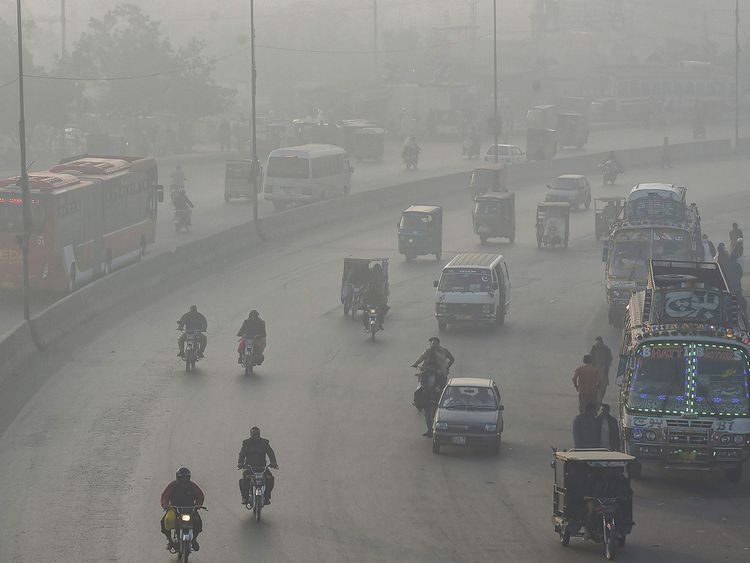Lahore has repeatedly topped its ranking as the most polluted city in the world.
Lahore has repeatedly topped ranking as the most polluted city in the world since last month. Pollution and smog are making people sick, disrupting everyday life. The air quality levels (AQI) in the city had remained hazardous and unhealthy for the whole of November and December, according to IQ Air monitoring platform.
“My children frequently experience breathing and coughing issues because of this killer smog. I feel like there’s no option but to leave this city” Sarah Rashid, a resident of Lahore, told Gulf News. But not everyone can afford to leave the megacity of more than 11 million people.
Citizens appeal to PM to take action
To make the city livable, some concerned citizens are making every effort such as installing air quality monitoring devices and judicial activism to compel Punjab authorities to take action. Dismayed by the response of the provincial government, a group of young climate activists and experts took their desperate appeal to the front page of mainstream newspapers with a half-page ad titled “Air Apocalypse, mask-clad Lahore looks for answers.”
They appealed to Prime Minister Imran Khan to take immediate actions and implement policies to improve air quality following the letdown by the Punjab government that resulted in toxic air in and around Lahore.
“We need urgent action”
Environmental lawyer Ahmad Rafay Alam who has been campaigning for clean air since 2016 told Gulf News that the concerned citizens of Lahore are making every effort to raise alarms about air pollution. “This massive public health crisis cannot be avoided anymore,” he said. PM Imran Khan’s Pakistan Tehreek-e-Insaf (PTI) is the country’s first political party to include green agenda on its manifesto.
But the climate activists say that policies on air pollution have been “all talk and no action.” Alam says that sealing the factories and arresting the violators is “not enough” action. “What I care about is actual improvement in quality of air that we breathe.” He urged the government to focus on “science-based policy” to gradually improve air quality. “We need urgent action.”
• Shift from coal and gas power stations and diesel generators to renewables such as solar, wind and hydropower.
• Replace diesel and gasoline-powered vehicles with electric vehicles through a mix of policies such as subsidies.
• Stricter standards for vehicle emissions and fuel quality control in trucks, buses, cars, bikes, rickshaws and chingchi. Move up to Euro V standards to remove air pollution and CO2 levels.
• Preventing crop burning and switching to the latest technologies.
• Focus on awareness and capacity building of key sectors such as transport, agriculture, industries, urban waste management.
• Create green spaces in cities and prioritise walking, cycling and public transport over cars in urban areas
• Strengthen environmental governance and promote green investments.
What causes air pollution in Lahore?
The main sources of air pollution in Lahore are vehicle and industrial emissions, smoke from brick kilns, the burning of crop residue and general waste, and dust from construction sites. The air quality in Lahore is bad throughout the year but people only realise it in winter months when warm air traps all the pollutants leading to low visibility, inter-city traffic disruption and frequent health issues.
Major public health crisis
The problem is worsening in Lahore in the populous Punjab province but the situation in other major cities such as the coastal city of Karachi is not better either. Pakistan is the world’s fourth most polluted country where air pollution shortens the average life expectancy by 4.3 years, according to Air Quality Life Index.
The provincial Environment Protection Department is tracking and reporting air quality data but some experts claim that the data is unreliable which leads to downplaying the severity of the issue. However, a community-driven effort has been launched by the citizens under Pakistan Air Quality Initiative (PAQI) to monitor air quality data by installing 50 monitors across Pakistan, including 30 in Lahore.
Measures taken by government
Climate Change Minister Malik Amin Aslam in a recent interview said that the government is taking significant steps to curb air pollution. These measures include installing more monitoring devices, shifting to fuel-efficient brick kilns, curbing open crop stubble by replacing it with happy seeder machines, moving up to Euro V standards to reduce vehicle emissions, launching vehicular fitness testing, and introducing electric cars and electric buses in public transportation.
Pakistan needs “drastic steps or the cities would become unlivable” Aslam warned. “We need to create livable zones and pedestrian zones, increase the use of public transport, and also introduce congestion charges at peak times,” he said, citing the example of city of London where congestion fees led to some reduction in traffic jams and pollution. He also called for a regional framework to control the transboundary pollution flow as crop fires from India sweep into Pakistan, worsening the situation.
Recommendations
Experts have suggested that Pakistan should learn lessons from China which made tremendous progress by declaring a war against pollution in the last decade, cutting its particulate pollution by about 30 per cent and improving life expectancy.
https://gulfnews.com/world/asia/pakistan/smog-choked-pakistanis-demand-urgent-action-on-air-pollution-from-pm-1.1641050955790

No comments:
Post a Comment